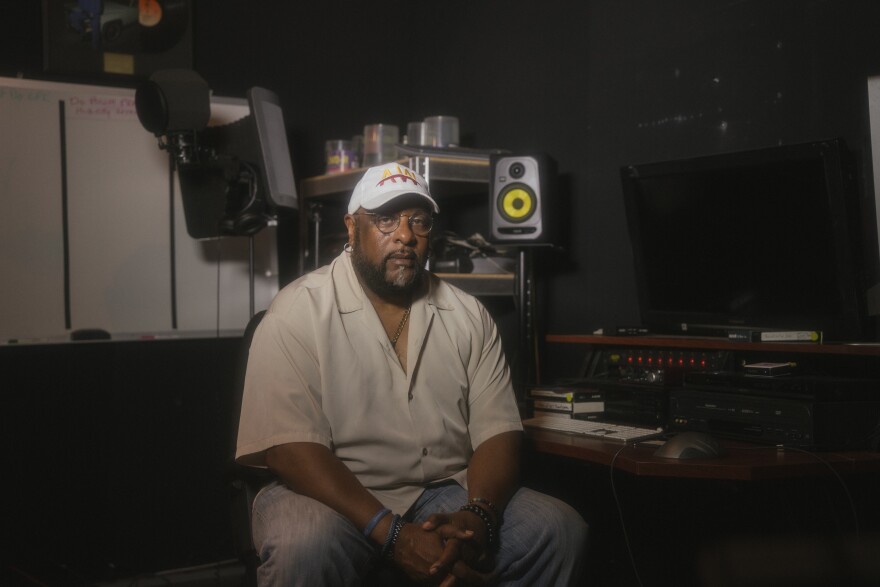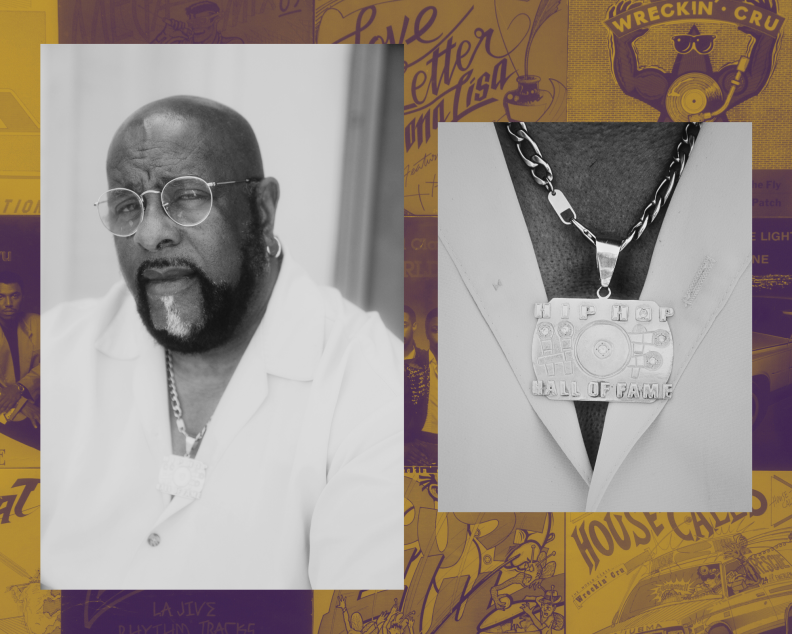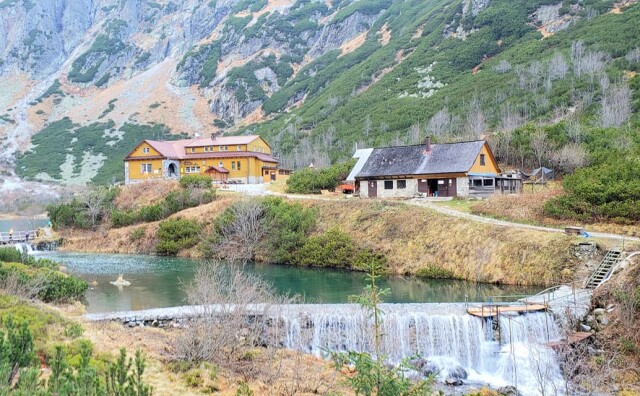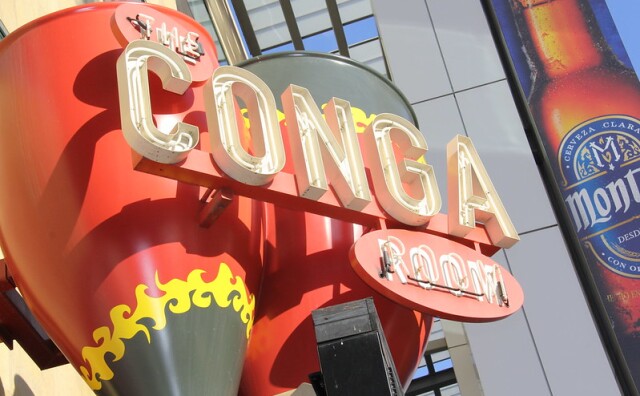Understanding The West Coast Hip-Hop Movement With Its 'Godfather'

Unlike its New York origin story, no one can really say exactly when hip-hop hit the West Coast. But when it did, Alonzo Williams was there.
Known as the “godfather” of West Coast hip-hop, Williams has been working in the music industry here for more than 40 years. He’s been a DJ, music producer, former club owner, and member of the World Class Wreckin’ Cru with Dr. Dre, DJ Yella and artists like Michel'le.
His studio in Gardena is where West Coast hip-hop history was made.
“This house is like the Motown House of West Coast hip-hop,” Williams says, recalling the first moments he recorded with collaborators. “It could be haunted with music.”
This is where Williams made the first Wreckin’ Cru record, the electro-funk group credited for pioneering West Coast hip-hop. He also recorded and produced hits for Dr. Dre and other hip-hop legends like Ice Cube and Eazy-E here.
“I wasn't trying to be the godfather,” Williams says, “I just was doing me.”
The studio’s musical history goes way back to when before hip-hop existed. Before Williams, it was previously owned by Johnny Otis — a singer, composer and record producer known as the “godfather” of rhythm and blues in the late '40s and '50s. Jazz icon Etta James, a mutual friend who lived right next door, also recorded much of her generation-defining music right there.
Disco and funk set the scene
It all started with disco.
“In the beginning it was all about partying,” Williams says. “It was all about dancing, it was all about having a good time.”
-
Proposal involves changes to L.A. city charter
-
State to audit Huntington Beach airshow settlement
-
Listen: LA ethics reforms, landlord relief, more
He recalls growing up in Compton and falling in love with the dance and club scene through his high school dances. “We didn’t have a lot of the luxuries kids have today, but it was a much better time,” he recalls.
Influenced by the disco groove, he later became a local DJ known as Disco Lonzo.
At the same time, the musical variety show Soul Train was blowing up in L.A., which featured Black musicians and dancers from L.A. (It first began to broadcast from Chicago, then moved here in 1971 when it was syndicated.)
“The show really made an opportunity for not only Black artists to get their music out, but for a presentation of Black dance and expression that the world had really never seen,” says historian of Black culture and museum curator Tyree Boyd-Pates.
“This is what I grew up on,” Wiliams says. “It was just an all around good time.”
But disco — known to be popular among queer, Latino and Black communities — died down toward the late '70s, due, many will argue today, to nationwide racism and homophobia.
The end was most visible in 1979, at Chicago’s Comiskey Park’s “Disco Demolition” night. That night, in a baseball promotion gone wrong, a popular DJ well known for being an anti-disco “discophobe” blew up disco records at a scheduled White Sox game. Hordes of people showed up, chaos ensued and the White Sox had to forfeit the game. Historical observers of that night are split about what exactly went down — some still view it a badly mishandled attempt to get people to the game while others saw it as a symbolic rejection of the genre and its supposed representation of queer culture.
But soon, a new kind of sound began to take the L.A. club scene by storm: funk music. Bands like KC and the Sunshine Band, The Sugarhill Gang and Brass Construction became the soundtrack at the hottest nightclubs.
Williams, who had recently opened the nightclub Eve After Dark in Compton, says funk, more so than disco, was truly the sound of L.A.’s Black community. “It was the sound of the young urban Blacks of the 70s,” Williams says. “Disco was cool, but it wasn't ours.”
Funk became the foundation for what would become the West Coast sound of a brand new genre that was, like disco, all about rhythm and movement.
“Funk is very repetitive,” Williams says. “It does the same thing every four bars for the most part, like James Brown is the master of repetition … He takes you high and brings you back down for the same 16 bars.”
Along with the advent of mechanical drum machines, funk’s repetition paved the way for the idea of sampling, reusing a portion of a song under a hip-hop beat, and ultimately, the West Coast hip-hop sound: “It became the basis of hip hop,” Williams says. “You could sit there and tap and make drum sounds. You can get a keyboard and sample, you could do almost anything.”
World Class Wreckin’ Cru
Playing around with funk samples, drum beats and flows in Williams’ studio soon became The World Class Wreckin' Cru — the first West Coast hip-hop group to be signed by a major label in 1983. Williams formed the group and brought in Dr. Dre, DJ Yella and Michel’le.
“We just took the elements that we'd already had, and basically rap was nothing but poetry to a beat,” he says.

Considered the first West Coast hip-hop group, but technically “electro-funk,” Wreckin’ Cru was the first group on the coast to rap over a sampled beat, to create what is now the distinctive West Coast sound. Williams says these specific ingredients — the rapping, the sampling, the drum machines — opened the door for many Black people with a story to tell to express themselves with music.
“Growing up in Compton, I always wanted to be a Temptation,” Williams recalls, laughing. “I knew I couldn’t sing, but I could write.”
Roots in revolution
Beyond the influences of disco and funk, Williams emphasizes the true origins of hip-hop go back far before the inception of those genres. It’s all about storytelling, he says.
Black Americans have used spoken word over music to tell stories from their community for centuries. Tracing it back to the 1800s, Williams refers to the songs enslaved Black people would sing in the fields on the plantations as a tool to both process and communicate their experiences.
“All those stories of people's lives that were put to music,” he says. “Hip-hop is just another vehicle used to tell the stories of our community.”

“Hip-hop, especially in the West Coast, is rooted in revolution,” Boyd-Pates says, nodding to the influence of poetry and spoken word among L.A.’s Black population during the 1965 Watts Rebellion.
Groups like the Last Poets in New York and the Watts Prophets in L.A. rose out of the Civil Rights movement to fuse the sounds of jazz and funk and spoken word to chronicle Black life in America, Boyd-Pates says. A 1965 radio broadcast by the Afro-American Association featured Black voices set to a beat, documenting the Watts Rebellion. It was titled: The Uncensored Version of The Los Angeles Riots.
“You’re gunna hear an analysis of Los Angeles that you won’t hear on the news,” one of the speakers says. “Los Angeles, it’s not a riot, it’s a war.”
“They used their poems and their words accompanied with sound to serve as a clarion call to Black conditioning here, particularly in South Los Angeles,” Boyd-Pates says of the artists of that time.
That gave rise to what came to define hip-hop and rap in its early days — the work of Dr. Dre, Eazy-E and NWA and albums like Straight Outta Compton. “It gave the whole world, especially through gangsta rap of the 1990s, a journalistic view of what it meant to be Black in L.A.,” Boyd-Pates says. “And you had movies like Boyz n the Hood that paralleled that same experience.”
Enter: Gangsta rap
This West Coast hip-hop renaissance lasted a few years, giving rise to regional giants like Dr. Dre, Eazy-E, Ice Cube, Ice-T and Snoop Dogg — “it was the golden age of hip-hop,” Williams says. “We were partying on the weekend and in the studio during the week.”
But then — much due to crack cocaine and other drugs hitting the streets on L.A. — the texture of the scene drastically changed.

“It was basically overnight,” Williams explains. “Suddenly everyone was a gangster, and you could hear it in the music.”
Lyrically, as the music shifted from love, romance and dance to a much more explicit tone of gun violence, drugs and sex, so did the energy at the clubs and in the streets, Williams says. This was the era that belonged to NWA, Tupac, Too Short; East Coast v. West Coast beef hit a high point (though many say this was purposely stoked by the media).
“Gangster rap killed electro funk,” Williams says, “The dance floor was no longer an option.”
Though this was a troubling time for the hip-hop scene in general — that included the shooting murders of hip-hop legends Tupac and Biggie Smalls — gangster rap was an influential musical element to the development of not just the genre, but hip-hop’s service for the journalism and preservation of Black culture in America.

“The music industry changed after Dr. Dre dropped The Chronic,” says Boyd-Pates. “The industry was never the same and gangsta rap was ushering in Death Row Records, Snoop Doggy Dogg and naturally Tupac who took it to heights the world had never seen … and all of that has ties to L.A.’s culture at large, especially Black culture.”
West Coast hip-hop forever
Today’s L.A. legends like Kendrick Lamar and Nipsey Hussle, Tyler the Creator, Inglewood Sir, each carry forth the elements of this West Coast sound. You can hear its collective history — the disco, the funk, soul, gospel, and gangster rap — in music today.
Hip-hop may have started in New York years before it really reached L.A., and the East Coast sound may have reigned in the beginning. But the hip-hop sound established here was its own. It made an impression and it persisted, Williams notes.
“One thing about L.A. that made L.A. so great in so many ways is that it was spread out,” says Williams. “L.A. County is huge and everyone wanted their own recognition so when Compton made its stamp on hip-hop, Long Beach had to follow, Pomona had to follow, Inglewood followed and it created a competition but helped anchor the West.”
“Then Northern California did their thing,” Williams adds, “and just between California alone you gotta a whole lotta hip-hop. And most of it sounds totally different. That is the beauty of the West Coast.”
-
A new trend in travel focuses on disconnecting from modern life and reconnecting with oneself in nature. It's called a "quiet vacation."
-
Samy Kamienowicz, the man who founded the retail camera stores and became a fixture for the city's creative community, has died. Los Angeles pays tribute.
-
The music will live on through the nonprofit Conga Kids.
-
Known for its elaborate light displays, this year, the neighborhood is expecting a bigger crowd tied to the release of “Candy Cane Lane” on Amazon Prime Video.
-
Dancers at Star Garden demanded better working conditions — including protection from aggressive guests. Up next: An actual contract.
-
The Alliance of Motion Picture and Television Producers rejected the SAG-AFTRA union's request for a separate type of residual payment that actors would get once their programs hit streaming services.










